-
Consumer Complaints Classification using Machine Learning and Deep Learning.
The dataset comprises of Consumer Complaints on Financial products and we’ll see how to classify consumer complaints text into these categories: Debt collection, Consumer Loan, Mortgage, Credit card, Credit reporting, Student loan, Bank account or service, Payday loan, Money transfers, Other financial service, Prepaid card.
The classification task would help banking/financial institution to quickly identify and provide customized solutions to each customer based on complaints received department wise. The dataset is available in link:- https://www.kaggle.com/cfpb/us-consumer-finance-complaints
We have performed initial analysis using text data with plots and word cloud for each department and performed various text pre-processing steps including Text Standardization,Removing Stopwords,Lemmatization,Spelling correction etc.Utilized Machine learning and Deep Learning methods to classify text data into 11 categories.
import numpy as np
import pandas as pd
from sklearn.feature_extraction.text import TfidfVectorizer
import sklearn.feature_extraction.text as text
from sklearn import model_selection, preprocessing, linear_model, naive_bayes, metrics, svm
from sklearn.naive_bayes import MultinomialNB
from sklearn.linear_model import LogisticRegression
from sklearn.ensemble import RandomForestClassifier
from sklearn.svm import LinearSVC
from sklearn.model_selection import cross_val_score
from sklearn.model_selection import train_test_split
from textblob import TextBlob
from nltk.stem import PorterStemmer,SnowballStemmer
from textblob import Word
from sklearn.feature_extraction.text import CountVectorizer,TfidfVectorizer
from nltk.corpus import stopwords
from nltk.tokenize import sent_tokenize, word_tokenize
from nltk.tokenize.toktok import ToktokTokenizer
from io import StringIO
import os
import string
import gensim
from gensim.models import Word2Vec
import itertools
import scipy
from scipy import spatial
import seaborn as sns
import matplotlib.pyplot as plt
import re
import nltk
tokenizer = ToktokTokenizer()
stopword_list = nltk.corpus.stopwords.words('english')
import warnings
warnings.filterwarnings("ignore")
nltk.download('stopwords')
[nltk_data] Downloading package stopwords to /home/hadoop/nltk_data...
[nltk_data] Package stopwords is already up-to-date!
True
nltk.download('wordnet')
[nltk_data] Downloading package wordnet to /home/hadoop/nltk_data...
[nltk_data] Package wordnet is already up-to-date!
True
df = pd.read_csv("consumer_complaints.csv")
df.head()
| date_received | product | sub_product | issue | sub_issue | consumer_complaint_narrative | company_public_response | company | state | zipcode | tags | consumer_consent_provided | submitted_via | date_sent_to_company | company_response_to_consumer | timely_response | consumer_disputed? | complaint_id | |
|---|---|---|---|---|---|---|---|---|---|---|---|---|---|---|---|---|---|---|
| 0 | 08/30/2013 | Mortgage | Other mortgage | Loan modification,collection,foreclosure | NaN | NaN | NaN | U.S. Bancorp | CA | 95993 | NaN | NaN | Referral | 09/03/2013 | Closed with explanation | Yes | Yes | 511074 |
| 1 | 08/30/2013 | Mortgage | Other mortgage | Loan servicing, payments, escrow account | NaN | NaN | NaN | Wells Fargo & Company | CA | 91104 | NaN | NaN | Referral | 09/03/2013 | Closed with explanation | Yes | Yes | 511080 |
| 2 | 08/30/2013 | Credit reporting | NaN | Incorrect information on credit report | Account status | NaN | NaN | Wells Fargo & Company | NY | 11764 | NaN | NaN | Postal mail | 09/18/2013 | Closed with explanation | Yes | No | 510473 |
| 3 | 08/30/2013 | Student loan | Non-federal student loan | Repaying your loan | Repaying your loan | NaN | NaN | Navient Solutions, Inc. | MD | 21402 | NaN | NaN | 08/30/2013 | Closed with explanation | Yes | Yes | 510326 | |
| 4 | 08/30/2013 | Debt collection | Credit card | False statements or representation | Attempted to collect wrong amount | NaN | NaN | Resurgent Capital Services L.P. | GA | 30106 | NaN | NaN | Web | 08/30/2013 | Closed with explanation | Yes | Yes | 511067 |
df.dtypes
date_received object
product object
sub_product object
issue object
sub_issue object
consumer_complaint_narrative object
company_public_response object
company object
state object
zipcode object
tags object
consumer_consent_provided object
submitted_via object
date_sent_to_company object
company_response_to_consumer object
timely_response object
consumer_disputed? object
complaint_id int64
dtype: object
df.describe(include='all')
| date_received | product | sub_product | issue | sub_issue | consumer_complaint_narrative | company_public_response | company | state | zipcode | tags | consumer_consent_provided | submitted_via | date_sent_to_company | company_response_to_consumer | timely_response | consumer_disputed? | complaint_id | |
|---|---|---|---|---|---|---|---|---|---|---|---|---|---|---|---|---|---|---|
| count | 555957 | 555957 | 397635 | 555957 | 212622 | 66806 | 85124 | 555957 | 551070 | 551452 | 77959 | 123458 | 555957 | 555957 | 555957 | 555957 | 555957 | 5.559570e+05 |
| unique | 1608 | 11 | 46 | 95 | 68 | 65646 | 10 | 3605 | 62 | 27052 | 3 | 4 | 6 | 1557 | 8 | 2 | 2 | NaN |
| top | 08/27/2015 | Mortgage | Other mortgage | Loan modification,collection,foreclosure | Account status | This company continues to report on my credit ... | Company chooses not to provide a public response | Bank of America | CA | 300XX | Older American | Consent provided | Web | 11/13/2015 | Closed with explanation | Yes | No | NaN |
| freq | 963 | 186475 | 74319 | 97191 | 26798 | 37 | 52478 | 55998 | 81700 | 1205 | 45257 | 66807 | 361338 | 1108 | 404293 | 541909 | 443823 | NaN |
| mean | NaN | NaN | NaN | NaN | NaN | NaN | NaN | NaN | NaN | NaN | NaN | NaN | NaN | NaN | NaN | NaN | NaN | 9.600510e+05 |
| std | NaN | NaN | NaN | NaN | NaN | NaN | NaN | NaN | NaN | NaN | NaN | NaN | NaN | NaN | NaN | NaN | NaN | 5.504296e+05 |
| min | NaN | NaN | NaN | NaN | NaN | NaN | NaN | NaN | NaN | NaN | NaN | NaN | NaN | NaN | NaN | NaN | NaN | 1.000000e+00 |
| 25% | NaN | NaN | NaN | NaN | NaN | NaN | NaN | NaN | NaN | NaN | NaN | NaN | NaN | NaN | NaN | NaN | NaN | 4.863230e+05 |
| 50% | NaN | NaN | NaN | NaN | NaN | NaN | NaN | NaN | NaN | NaN | NaN | NaN | NaN | NaN | NaN | NaN | NaN | 9.737830e+05 |
| 75% | NaN | NaN | NaN | NaN | NaN | NaN | NaN | NaN | NaN | NaN | NaN | NaN | NaN | NaN | NaN | NaN | NaN | 1.441702e+06 |
| max | NaN | NaN | NaN | NaN | NaN | NaN | NaN | NaN | NaN | NaN | NaN | NaN | NaN | NaN | NaN | NaN | NaN | 1.895894e+06 |
df.isnull().sum()/df.shape[0]*100
date_received 0.000000
product 0.000000
sub_product 28.477382
issue 0.000000
sub_issue 61.755675
consumer_complaint_narrative 87.983603
company_public_response 84.688744
company 0.000000
state 0.879025
zipcode 0.810314
tags 85.977513
consumer_consent_provided 77.793606
submitted_via 0.000000
date_sent_to_company 0.000000
company_response_to_consumer 0.000000
timely_response 0.000000
consumer_disputed? 0.000000
complaint_id 0.000000
dtype: float64
df1 = df[['complaint_id','date_received','product','issue','company','state','submitted_via','company_response_to_consumer','timely_response','consumer_disputed?','consumer_complaint_narrative']]
df1 = df1[pd.notnull(df1['consumer_complaint_narrative'])]
EDA
We’ll check the disribution of complaints by product category to understand which product received maximum complaints and other products which rarely receive complaints.
fig,ax = plt.subplots(figsize=(18,6))
sns.countplot(x='product',data=df1)
<matplotlib.axes._subplots.AxesSubplot at 0x7f7cf81fd0b8>

From this plot we can see Debt Collection and Mortgage received maximum number of complaints
We’ll now analyze the contingency table in form of plot to understand which product has more customer disputes on their complaints after resolving the issues
pd.crosstab(df1['product'],df1['consumer_disputed?']).plot(kind='bar')
<matplotlib.axes._subplots.AxesSubplot at 0x7f7cf81a2b00>

Not much of difference in proportion of disputes raised by complaint for each product category.
Checking various plots to identify patterns within data
df1['date_received'] = pd.to_datetime(df1['date_received'])
df1.date_received.min(),df1.date_received.max()
(Timestamp('2015-03-19 00:00:00'), Timestamp('2016-04-20 00:00:00'))
df1['month'] = df1['date_received'].dt.month
sns.countplot(x='month',data=df1)
<matplotlib.axes._subplots.AxesSubplot at 0x7f7e1484dbe0>

sns.countplot(x='timely_response',data=df1)
<matplotlib.axes._subplots.AxesSubplot at 0x7f7e156f71d0>

Text Data Preprocessing
Converting Text data to Lowercase
df1['consumer_complaint_narrative'] =df1['consumer_complaint_narrative'].apply(lambda x: ' '.join([i.lower() for i in x.split()]))
df1['consumer_complaint_narrative'].sample(2)
519427 i underwent an xxxx, prior to xxxx. this was p...
324017 i got a loan through the money source in xxxx ...
Name: consumer_complaint_narrative, dtype: object
Removing Punctuations
df1['consumer_complaint_narrative'] =df1['consumer_complaint_narrative'].str.replace(r'[^\w\s]',"")
df1['consumer_complaint_narrative'].sample(2)
239441 every day im at work security financial from x...
512626 while on vacation my account became overdrawn ...
Name: consumer_complaint_narrative, dtype: object
Text standardization
#Below, we used three normalizazion dictionaries from these links :
#http://www.hlt.utdallas.edu/~yangl/data/Text_Norm_Data_Release_Fei_Liu/
#http://people.eng.unimelb.edu.au/tbaldwin/etc/emnlp2012-lexnorm.tgz
#http://luululu.com/tweet/typo-corpus-r1.txt
dico = {}
dico1 = open('doc1.txt', 'rb')
for word in dico1:
word = word.decode('utf8')
word = word.split()
dico[word[1]] = word[3]
dico1.close()
dico2 = open('doc2.txt', 'rb')
for word in dico2:
word = word.decode('utf8')
word = word.split()
dico[word[0]] = word[1]
dico2.close()
dico3 = open('doc3.txt', 'rb')
for word in dico3:
word = word.decode('utf8')
word = word.split()
dico[word[0]] = word[1]
dico3.close()
def txt_std(words):
list_words = words.split()
for i in range(len(list_words)):
if list_words[i] in dico.keys():
list_words[i] = dico[list_words[i]]
return ' '.join(list_words)
df1['consumer_complaint_narrative'] = df1['consumer_complaint_narrative'].apply(txt_std)
df1.consumer_complaint_narrative.head(1)
190126 xxxx has claimed i owe them 2700 for xxxx year...
Name: consumer_complaint_narrative, dtype: object
df1['consumer_complaint_narrative'] = df1['consumer_complaint_narrative'].str.replace(r"xx+\s","")
df1['consumer_complaint_narrative'].head(1)
190126 has claimed i owe them 2700 for years despite ...
Name: consumer_complaint_narrative, dtype: object
Removing Stopwords
from nltk.corpus import stopwords
stop = stopwords.words('english')
df1['consumer_complaint_narrative'] =df1['consumer_complaint_narrative'].apply(lambda x: ' '.join([i for i in x.split() if i not in stop]))
df1['consumer_complaint_narrative'].head(1)
190126 claimed owe 2700 years despite proof payment s...
Name: consumer_complaint_narrative, dtype: object
Correcting Spelling
##ensure text is standardized before applying this step
from textblob import TextBlob
df1['consumer_complaint_narrative'] =df1['consumer_complaint_narrative'].apply(lambda x: str(TextBlob(x).correct()))
Lemmatizing
from textblob import Word
df1['consumer_complaint_narrative'] =df1['consumer_complaint_narrative'].apply(lambda x:' '.join([Word(i).lemmatize() for i in x.split()]))
df1.consumer_complaint_narrative.head(1)
190126 claimed owe 2700 year despite proof payment se...
Name: consumer_complaint_narrative, dtype: object
Word Cloud for all Product categories
for product_name in df1['product'].unique():
print(product_name)
all_words = ' '.join([text for text in df1.loc[df1['product'].str.contains(product_name),'consumer_complaint_narrative']])
from wordcloud import WordCloud
wordcloud = WordCloud(width=800, height=500, random_state=21, max_font_size=110).generate(all_words)
plt.figure(figsize=(10, 7))
plt.imshow(wordcloud, interpolation="bilinear")
plt.axis('off')
plt.show()
Debt collection

Consumer Loan

Mortgage
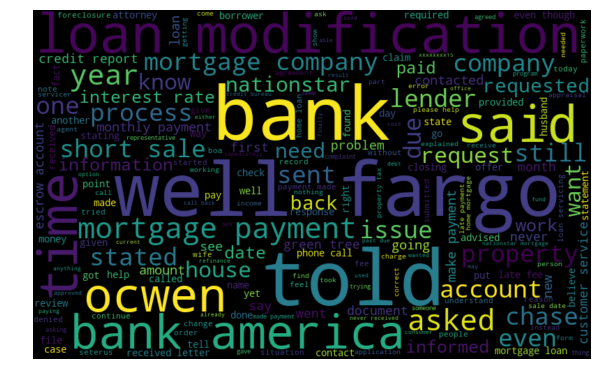
Credit card

Credit reporting

Student loan

Bank account or service

Payday loan

Money transfers

Other financial service

Prepaid card

Train/Test split
train_x, valid_x, train_y, valid_y = train_test_split(df1['consumer_complaint_narrative'], df1['product'],stratify=df1['product'],
test_size=0.25)
Feature engineering of consumer complaint with TF-IDF
##label encoding target variable
enc = preprocessing.LabelEncoder()
train_y = enc.fit_transform(train_y)
valid_y = enc.fit_transform(valid_y)
##tf-idf verctor representation
tfidf_vect = TfidfVectorizer(analyzer='word', token_pattern=r'\w{1,}', max_features=5000)
tfidf_vect.fit(df1['consumer_complaint_narrative'])
xtrain_tfidf = tfidf_vect.transform(train_x)
xvalid_tfidf = tfidf_vect.transform(valid_x)
from sklearn.model_selection import GridSearchCV
clf = LogisticRegression()
lr_params = {'C':[int(x) for x in np.linspace(1,10,10)]}
grid_lr = GridSearchCV(estimator=clf,param_grid=lr_params,cv=5,n_jobs=-1)
grid_lr.fit(xtrain_tfidf,train_y)
GridSearchCV(cv=5, error_score='raise-deprecating',
estimator=LogisticRegression(C=1.0, class_weight=None, dual=False, fit_intercept=True,
intercept_scaling=1, max_iter=100, multi_class='warn',
n_jobs=None, penalty='l2', random_state=None, solver='warn',
tol=0.0001, verbose=0, warm_start=False),
fit_params=None, iid='warn', n_jobs=-1,
param_grid={'C': [1, 2, 3, 4, 5, 6, 7, 8, 9, 10]},
pre_dispatch='2*n_jobs', refit=True, return_train_score='warn',
scoring=None, verbose=0)
print(grid_lr.best_params_)
print(grid_lr.best_score_)
{'C': 5}
0.8462398211719623
final_lr = LogisticRegression(C=5)
final_lr.fit(xtrain_tfidf,train_y)
LogisticRegression(C=5, class_weight=None, dual=False, fit_intercept=True,
intercept_scaling=1, max_iter=100, multi_class='warn',
n_jobs=None, penalty='l2', random_state=None, solver='warn',
tol=0.0001, verbose=0, warm_start=False)
final_lr_predict = final_lr.predict(xvalid_tfidf)
lr_accuracy = metrics.accuracy_score(final_lr_predict, valid_y)
print ("Logistic Regression > Accuracy: ", lr_accuracy)
Logistic Regression > Accuracy: 0.8506765656807568
from sklearn.metrics import classification_report
print(classification_report(valid_y, final_lr_predict,target_names=df1['product'].unique()))
precision recall f1-score support
Debt collection 0.83 0.79 0.81 1428
Consumer Loan 0.77 0.62 0.69 920
Mortgage 0.80 0.83 0.81 1982
Credit card 0.86 0.85 0.86 3132
Credit reporting 0.83 0.89 0.85 4388
Student loan 0.77 0.64 0.70 166
Bank account or service 0.93 0.96 0.94 3730
Payday loan 1.00 0.04 0.07 27
Money transfers 0.68 0.36 0.47 182
Other financial service 0.80 0.70 0.74 215
Prepaid card 0.87 0.77 0.82 532
micro avg 0.85 0.85 0.85 16702
macro avg 0.83 0.68 0.71 16702
weighted avg 0.85 0.85 0.85 16702
from sklearn.metrics import confusion_matrix
conf_mat = confusion_matrix(valid_y, final_lr_predict)
fig, ax = plt.subplots(figsize=(8,6))
sns.heatmap(conf_mat, annot=True, fmt="d", cmap="BuPu",xticklabels=df1['product'].unique(),yticklabels=df1['product'].unique())
plt.ylabel('Actual')
plt.xlabel('Predicted')
plt.show()
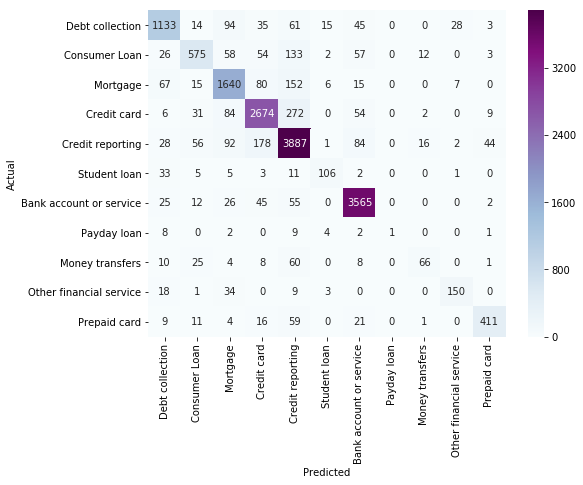
We have acheived an accuracy of around 85% with a Logistic Regression model and the classification metrics are good for all departments except Payday loan - this might be due to less training instances of this product category and also on looking at the confusion matrix it is mostly being predicted as Credit reporting or debt collection which gives us an indication that this product is similar to one another or maybe linked with other.
We might further improve the performance using Random Forest, SVM, GBM, Neural Networks and utilize hyperparameter tuning.
SVM
from sklearn.svm import LinearSVC
svc_model = LinearSVC()
svc_params = {'C':[0.01,0.1, 1, 10, 100, 1000]}
grid_svc = GridSearchCV(estimator=svc_model,param_grid=svc_params,cv=5,n_jobs=-1)
grid_svc.fit(xtrain_tfidf,train_y)
GridSearchCV(cv=5, error_score='raise-deprecating',
estimator=LinearSVC(C=1.0, class_weight=None, dual=True, fit_intercept=True,
intercept_scaling=1, loss='squared_hinge', max_iter=1000,
multi_class='ovr', penalty='l2', random_state=None, tol=0.0001,
verbose=0),
fit_params=None, iid='warn', n_jobs=-1,
param_grid={'C': [0.01, 0.1, 1, 10, 100, 1000]},
pre_dispatch='2*n_jobs', refit=True, return_train_score='warn',
scoring=None, verbose=0)
print(grid_svc.best_params_)
print(grid_svc.best_score_)
{'C': 0.1}
0.8435055085422322
final_svc = LinearSVC(C=0.1)
final_svc.fit(xtrain_tfidf,train_y)
LinearSVC(C=0.1, class_weight=None, dual=True, fit_intercept=True,
intercept_scaling=1, loss='squared_hinge', max_iter=1000,
multi_class='ovr', penalty='l2', random_state=None, tol=0.0001,
verbose=0)
final_svc_predict = final_svc.predict(xvalid_tfidf)
svc_accuracy = metrics.accuracy_score(final_svc_predict, valid_y)
print ("SVC > Accuracy: ", svc_accuracy)
SVC > Accuracy: 0.8482217698479224
print(classification_report(valid_y, final_svc_predict,target_names=df1['product'].unique()))
precision recall f1-score support
Debt collection 0.82 0.80 0.81 1428
Consumer Loan 0.81 0.58 0.68 920
Mortgage 0.80 0.83 0.81 1982
Credit card 0.87 0.85 0.86 3132
Credit reporting 0.82 0.89 0.85 4388
Student loan 0.81 0.61 0.69 166
Bank account or service 0.92 0.96 0.94 3730
Payday loan 0.00 0.00 0.00 27
Money transfers 0.73 0.30 0.42 182
Other financial service 0.80 0.65 0.72 215
Prepaid card 0.86 0.79 0.82 532
micro avg 0.85 0.85 0.85 16702
macro avg 0.75 0.66 0.69 16702
weighted avg 0.85 0.85 0.84 16702
conf_mat = confusion_matrix(valid_y, final_svc_predict)
fig, ax = plt.subplots(figsize=(8,6))
sns.heatmap(conf_mat, annot=True, fmt="d", cmap="BuPu",xticklabels=df1['product'].unique(),yticklabels=df1['product'].unique())
plt.ylabel('Actual')
plt.xlabel('Predicted')
plt.show()
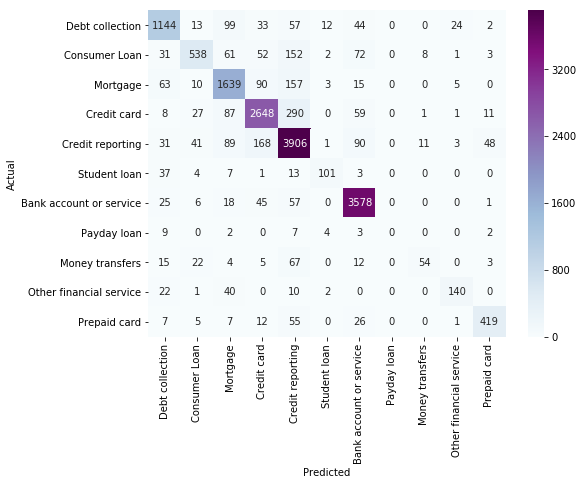
XGBOOST
from xgboost import XGBClassifier
xgb_model = XGBClassifier(max_depth=50, n_estimators=80, learning_rate=0.1, colsample_bytree=.7, gamma=0, reg_alpha=4, eta=0.3, silent=1, subsample=0.8)
xgb_model.fit(xtrain_tfidf_final, train_y)
XGBClassifier(base_score=0.5, booster='gbtree', colsample_bylevel=1,
colsample_bytree=0.7, eta=0.3, gamma=0, learning_rate=0.1,
max_delta_step=0, max_depth=50, min_child_weight=1, missing=None,
n_estimators=80, n_jobs=1, nthread=None, objective='multi:softprob',
random_state=0, reg_alpha=4, reg_lambda=1, scale_pos_weight=1,
seed=None, silent=1, subsample=0.8)
xgb_predict = xgb_model.predict(xvalid_tfidf_final)
xgb_accuracy = metrics.accuracy_score(xgb_predict, valid_y)
print ("XGBoost > Accuracy: ", xgb_accuracy)
XGBoost > Accuracy: 0.8533708537899652
from sklearn.metrics import classification_report
print(classification_report(valid_y, xgb_predict,target_names=df1['product'].unique()))
precision recall f1-score support
Debt collection 0.83 0.81 0.82 1432
Consumer Loan 0.77 0.60 0.67 936
Mortgage 0.81 0.82 0.82 1987
Credit card 0.86 0.87 0.87 3138
Credit reporting 0.83 0.89 0.86 4384
Student loan 0.89 0.59 0.71 173
Bank account or service 0.92 0.95 0.94 3704
Payday loan 1.00 0.05 0.10 19
Money transfers 0.60 0.37 0.45 178
Other financial service 0.82 0.73 0.77 220
Prepaid card 0.88 0.85 0.87 531
micro avg 0.85 0.85 0.85 16702
macro avg 0.84 0.68 0.72 16702
weighted avg 0.85 0.85 0.85 16702
from sklearn.metrics import confusion_matrix
conf_mat = confusion_matrix(valid_y, xgb_predict)
fig, ax = plt.subplots(figsize=(8,6))
sns.heatmap(conf_mat, annot=True, fmt="d", cmap="BuPu",xticklabels=df1['product'].unique(),yticklabels=df1['product'].unique())
plt.ylabel('Actual')
plt.xlabel('Predicted')
plt.show()
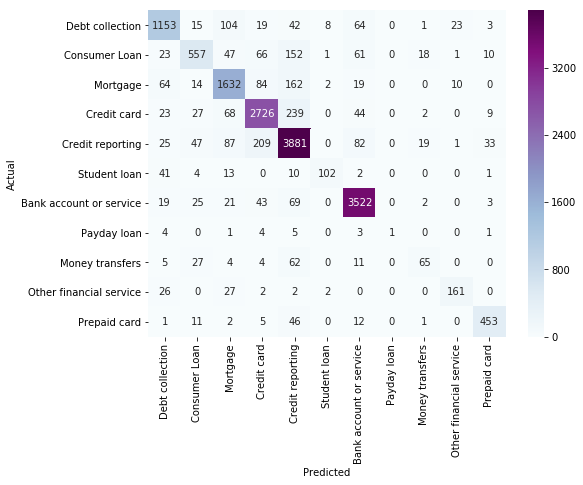
Deep Learning models
from keras.preprocessing.text import Tokenizer
from keras.preprocessing.sequence import pad_sequences
from keras.utils import to_categorical
from keras.layers import Dense, Input, LSTM, Embedding, Dropout, Activation
from keras.layers import Bidirectional, GlobalMaxPool1D, Conv1D, SimpleRNN
from keras.models import Model
from keras.models import Sequential
from keras import initializers, regularizers, constraints, optimizers, layers
from keras.layers import Dense, Input, Flatten, Dropout, BatchNormalization
from keras.layers import Conv1D, MaxPooling1D, Embedding
from keras.models import Sequential
Using TensorFlow backend.
#total_complaints = np.append(train_x.values,valid_x.values)
tokenizer = Tokenizer(num_words=25000)
tokenizer.fit_on_texts(train_x.values)#total_complaints
train_sequences = tokenizer.texts_to_sequences(train_x.values)
test_sequences = tokenizer.texts_to_sequences(valid_x.values)
word_index = tokenizer.word_index# dictionary containing words and their index
print('Found %s unique tokens.' % len(word_index))
Found 51128 unique tokens.
MAX_SEQUENCE_LENGTH = max([len(c.split()) for c in total_complaints])
MAX_SEQUENCE_LENGTH
394
train_data = pad_sequences(train_sequences, maxlen=max_length,padding='post')
test_data = pad_sequences(test_sequences, maxlen=max_length,padding='post')
print(train_data.shape)
print(test_data.shape)
(50104, 394)
(16702, 394)
enc = preprocessing.LabelEncoder()
train_labels = enc.fit_transform(train_y)
test_labels = enc.fit_transform(valid_y)
print(enc.classes_)
print(np.unique(train_labels, return_counts=True))
print(np.unique(test_labels, return_counts=True))
['Bank account or service' 'Consumer Loan' 'Credit card'
'Credit reporting' 'Debt collection' 'Money transfers' 'Mortgage'
'Other financial service' 'Payday loan' 'Prepaid card' 'Student loan']
(array([ 0, 1, 2, 3, 4, 5, 6, 7, 8, 9, 10]), array([ 4283, 2758, 5947, 9394, 13164, 500, 11189, 83, 544,
646, 1596]))
(array([ 0, 1, 2, 3, 4, 5, 6, 7, 8, 9, 10]), array([1428, 920, 1982, 3132, 4388, 166, 3730, 27, 182, 215, 532]))
labels_train = to_categorical(np.asarray(train_labels))
labels_test = to_categorical(np.asarray(test_labels))
print('Shape of data tensor:', train_data.shape)
print('Shape of label tensor:', labels_train.shape)
print('Shape of label tensor:', labels_test.shape)
Shape of data tensor: (50104, 394)
Shape of label tensor: (50104, 11)
Shape of label tensor: (16702, 11)
CNN w/ Pre-trained word embeddings(GloVe)
We’ll use pre-trained embeddings such as Glove which provides word based vector representation trained on a large corpus.
It is trained on a dataset of one billion tokens (words) with a vocabulary of 400 thousand words. The glove has embedding vector sizes, including 50, 100, 200 and 300 dimensions.
#wget http://nlp.stanford.edu/data/glove.6B.zip
GLOVE_DIR = '/mnt/data/temp/nlp/'
embeddings_index = {}
f = open(os.path.join(GLOVE_DIR, 'glove.6B.300d.txt'))
for line in f:
values = line.split()
word = values[0]
coefs = np.asarray(values[1:], dtype='float32')
embeddings_index[word] = coefs
f.close()
print('Found %s word vectors.' % len(embeddings_index))
Found 400000 word vectors.
Now lets create the embedding matrix using the word indexer created from tokenizer.
EMBEDDING_DIM = 300
embedding_matrix = np.zeros((len(word_index) + 1, EMBEDDING_DIM))
for word, i in word_index.items():
embedding_vector = embeddings_index.get(word)
if embedding_vector is not None:
# words not found in embedding index will be all-zeros.
embedding_matrix[i] = embedding_vector
Lets check the word embedded vector representation for token ‘loan’ in our embedding matrix
[(k,v) for k,v in word_index.items() if v==4]
[('loan', 4)]
embedding_matrix[4] ## word embedded vector representation for token 'loan'
array([ 0.13474999, 0.063568 , -0.37950999, -0.080729 , 0.34176001,
-0.0053481 , 0.80001003, -0.78824002, -0.47262999, -0.89402002,
0.086908 , -0.051773 , 0.57349998, -0.26681 , -0.0043554 ,
-0.68673003, 0.54759002, -0.47711 , 0.12997 , -0.50748003,
0.073666 , -0.56199998, 0.19243 , -0.022735 , 0.15757 ,
0.68008 , -0.48374999, 0.14399 , -0.69022 , 0.26741001,
-0.53082001, -0.29096001, 0.32907999, 0.12313 , -1.14779997,
-0.51828998, -0.018956 , 0.02077 , -0.0015803 , -0.053114 ,
-0.10982 , -0.83578998, -0.46337 , 0.85992002, 0.57225001,
-0.33202001, -0.23357999, 0.80937999, -0.43586999, 0.35385001,
0.0055405 , 0.068909 , 0.13897 , 0.16237999, 0.038382 ,
-0.16306999, -0.022701 , 0.14324 , -0.25878 , -0.47661999,
0.25588 , -0.23389 , -0.14936 , -0.51688999, 0.44329 ,
0.49015 , 0.25725001, -0.45041999, 0.66949999, -0.32949001,
0.34626999, 0.91883999, 0.29245001, 0.20112 , 0.19018 ,
0.17321999, -0.3028 , 0.34022999, 0.49851999, -0.66885 ,
0.046698 , -0.19625001, -0.18028 , -0.41620001, 0.25986001,
-0.078103 , -0.33655 , 0.2077 , -0.69224 , 0.13703001,
-0.078832 , 0.26159 , -0.81893998, -0.35289001, 0.93794 ,
-0.1078 , -0.0944 , -0.11647 , 0.16785 , -0.32293001,
0.26176 , -0.37233001, 0.20868 , 0.040312 , -0.10222 ,
0.03121 , -0.09023 , 0.10476 , -0.042395 , 0.43564999,
0.18483 , -0.37215999, -0.21328001, -0.38079 , 0.39579999,
-0.32354999, 0.36971 , 0.036001 , 0.27676001, -0.19016001,
0.45638999, -0.16368 , -0.28349 , 1.09430003, 0.42951 ,
0.31263 , -0.24164 , -0.65586001, 0.42745 , 0.062487 ,
0.13004 , 0.40292001, 0.36722001, 0.2735 , 0.41966999,
0.22131 , 0.11602 , 0.22048999, -0.70600998, -0.35673001,
0.30159 , 0.1577 , 0.50809997, -0.17802 , -0.1236 ,
0.039545 , -0.47681001, -0.27853999, 0.022819 , -0.34139001,
0.057525 , -0.19609 , -0.47088999, -0.094618 , 0.03156 ,
0.17686 , 0.1304 , -0.19153 , -1.01779997, 0.27147001,
-0.094474 , 0.19495 , -0.22766 , 0.48361999, -0.15542001,
-0.31952 , 0.18727 , -0.20431 , 0.17941 , 0.39689001,
-0.22562 , 0.22657 , -0.39245999, 0.13325 , 0.11315 ,
-0.0089568 , -0.39331999, -0.42818999, -0.050899 , 0.98714 ,
0.70963001, -0.73843002, 0.0015733 , -0.22325 , -0.032507 ,
0.068939 , -0.061416 , 0.27745 , 0.81079 , 0.068871 ,
-0.11854 , 1.23679996, -0.2137 , 0.14869 , -0.10408 ,
-0.28125 , 0.44893 , -0.020156 , -0.24044999, -0.26190999,
0.39906001, 0.083602 , -0.36026001, 0.099067 , 0.32196999,
-0.52192003, -0.20076001, 0.22297999, -0.55962998, -0.043737 ,
-0.11283 , -0.12897 , 0.087192 , -0.27746001, 0.36127999,
0.50796002, 0.0031916 , 0.42192 , -0.61040002, 0.31369001,
0.32049 , -0.29355001, -0.59398001, -0.24123 , 0.052429 ,
-0.21264 , -0.086706 , 0.21190999, 0.15614 , 0.20209999,
-0.52890998, 0.22271 , -0.034363 , -0.047417 , 0.57754999,
-0.13970999, -0.1857 , 0.30785999, 0.903 , 0.33508 ,
0.84836 , 0.14651 , 0.65511 , -0.13307001, -0.89139003,
0.45642 , -0.027791 , -0.70120001, -0.036094 , -0.048917 ,
-0.28738999, 0.37559 , 0.19429 , 0.26212001, 0.27517 ,
-0.20432 , -1.36479998, 0.41104999, 0.21875 , 0.023549 ,
-0.37918001, 0.90345001, -0.061026 , 0.39754999, -0.30871999,
0.066477 , 0.36392999, 0.30715999, -0.010557 , -0.068205 ,
0.43869999, -0.39995 , -0.67673999, 0.41769999, 1.01440001,
-0.043677 , -0.87041003, -0.43674999, 0.53908998, 0.13293 ,
-0.16768999, -0.033394 , 0.29978001, 0.24638 , 0.077386 ,
0.73455 , 0.20106 , -0.31229001, 0.44185999, -0.64885002,
-0.50042999, 0.40474001, -0.31336999, -0.93396997, 1.26020002,
0.38231999, 0.51256001, -0.27717999, -0.83829999, 0.19851001])
vocab_size = len(tokenizer.word_index)+1
Now we load this embedding matrix into an Embedding layer using Sequential API to form a Convolutional NeuralNet model.
Dropout is applied between the hidden layers to factor regularization and prevent overfitting of neural network.
model = Sequential()
model.add(Embedding(len(word_index) + 1,
EMBEDDING_DIM,
weights=[embedding_matrix],
input_length=MAX_SEQUENCE_LENGTH,
trainable=True))
model.add(Dropout(0.3))
model.add(Conv1D(128, 5, activation="relu"))
model.add(MaxPooling1D(5))
model.add(Dropout(0.3))
model.add(BatchNormalization())
model.add(Conv1D(128, 5, activation="relu"))
model.add(MaxPooling1D(5))
model.add(Dropout(0.3))
model.add(BatchNormalization())
model.add(Flatten())
model.add(Dense(128, activation="relu"))
model.add(Dense(11, activation="softmax"))
model.compile(loss='categorical_crossentropy',
optimizer="rmsprop",
metrics=['acc'])
history = model.fit(train_data, labels_train,
batch_size=64,
epochs=8,
validation_data=(test_data, labels_test))
Train on 50104 samples, validate on 16702 samples
Epoch 1/8
50104/50104 [==============================] - 44s 872us/step - loss: 0.9975 - acc: 0.6868 - val_loss: 0.6876 - val_acc: 0.7930
Epoch 2/8
50104/50104 [==============================] - 41s 816us/step - loss: 0.6593 - acc: 0.8016 - val_loss: 0.5794 - val_acc: 0.8284
Epoch 3/8
50104/50104 [==============================] - 42s 836us/step - loss: 0.5721 - acc: 0.8300 - val_loss: 0.5572 - val_acc: 0.8400
Epoch 4/8
50104/50104 [==============================] - 42s 832us/step - loss: 0.5236 - acc: 0.8423 - val_loss: 0.5348 - val_acc: 0.8419
Epoch 5/8
50104/50104 [==============================] - 41s 826us/step - loss: 0.4910 - acc: 0.8520 - val_loss: 0.5241 - val_acc: 0.8502
Epoch 6/8
50104/50104 [==============================] - 41s 810us/step - loss: 0.4615 - acc: 0.8612 - val_loss: 0.5449 - val_acc: 0.8505
Epoch 7/8
50104/50104 [==============================] - 41s 809us/step - loss: 0.4447 - acc: 0.8687 - val_loss: 0.5550 - val_acc: 0.8528
Epoch 8/8
50104/50104 [==============================] - 41s 811us/step - loss: 0.4213 - acc: 0.8735 - val_loss: 0.5559 - val_acc: 0.8568
fig1 = plt.figure()
plt.plot(history.history['loss'],'r',linewidth=3.0)
plt.plot(history.history['val_loss'],'b',linewidth=3.0)
plt.legend(['Training loss', 'Validation Loss'],fontsize=18)
plt.xlabel('Epochs ',fontsize=16)
plt.ylabel('Loss',fontsize=16)
plt.title('Loss Curves :CNN',fontsize=16)
plt.show()
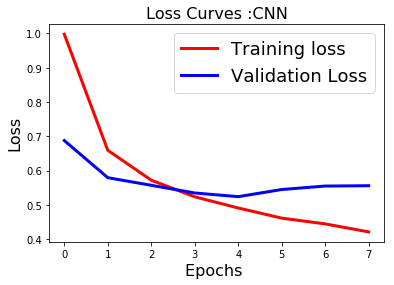
After 3 epochs the CNN tends to be overfitting the training data and therefore we need to implement early stopping to prevent such instances of overfitting and tune the number of epochs during training.
#predictions on test data
predicted=model.predict(test_data)
predicted
array([[8.07726883e-06, 6.62703314e-05, 1.78964832e-03, ...,
6.29637427e-08, 1.20558980e-07, 1.14476046e-04],
[2.95381608e-10, 1.03029949e-08, 1.18816992e-08, ...,
3.01563633e-19, 2.13277332e-30, 3.77692539e-12],
[5.53291329e-06, 1.50882616e-03, 4.29511711e-04, ...,
5.21915681e-05, 5.36095501e-10, 1.35198381e-04],
...,
[3.19875457e-04, 2.95074121e-03, 7.61984801e-03, ...,
5.84271547e-05, 3.93354838e-07, 1.12289046e-04],
[5.23970462e-03, 1.25093470e-06, 5.79587542e-08, ...,
3.22076106e-13, 1.34494688e-22, 5.08515097e-09],
[1.74894019e-08, 1.55232010e-05, 1.46042012e-05, ...,
8.76272254e-14, 4.28086869e-22, 6.98745950e-08]], dtype=float32)
#model evaluation
import sklearn
from sklearn.metrics import precision_recall_fscore_support as score
precision, recall, fscore, support = score(labels_test, predicted.round())
print('precision: \n{}'.format(precision))
print('recall: \n{}'.format(recall))
print('fscore: \n{}'.format(fscore))
print('support: \n{}'.format(support))
precision:
[0.86736334 0.76771654 0.85052632 0.90071648 0.86662138 0.58522727
0.93119625 0. 0.55696203 0.74770642 0.88888889]
recall:
[0.75560224 0.63586957 0.81533804 0.84291188 0.87215132 0.62048193
0.95790885 0. 0.24175824 0.75813953 0.82706767]
fscore:
[0.80763473 0.69560048 0.83256054 0.87085601 0.86937756 0.60233918
0.94436368 0. 0.33716475 0.75288684 0.85686465]
support:
[1428 920 1982 3132 4388 166 3730 27 182 215 532]
print(classification_report(labels_test, predicted.round(),target_names=df1['product'].unique()))
precision recall f1-score support
Debt collection 0.87 0.76 0.81 1428
Consumer Loan 0.77 0.64 0.70 920
Mortgage 0.85 0.82 0.83 1982
Credit card 0.90 0.84 0.87 3132
Credit reporting 0.87 0.87 0.87 4388
Student loan 0.59 0.62 0.60 166
Bank account or service 0.93 0.96 0.94 3730
Payday loan 0.00 0.00 0.00 27
Money transfers 0.56 0.24 0.34 182
Other financial service 0.75 0.76 0.75 215
Prepaid card 0.89 0.83 0.86 532
micro avg 0.88 0.84 0.86 16702
macro avg 0.72 0.67 0.69 16702
weighted avg 0.87 0.84 0.86 16702
samples avg 0.84 0.84 0.84 16702
Now, we’ll initialize our Embedding layer from scratch and learning its weights during training instead of using a pre-trained word embeddings and build a small 1D convnet to solve our classification problem.
#The Embedding layer requires the specification of the vocabulary size (vocab_size),
#the size of the real-valued vector space EMBEDDING_DIM = 100,
#and the maximum length of input documents max_length .
vocab_size = len(tokenizer.word_index)+1
EMBEDDING_DIM = 300
max_length = 394
model = Sequential()
model.add(Embedding(vocab_size,
300,
input_length=max_length
))
model.add(Dropout(0.3))
model.add(Conv1D(128, 5, activation="relu"))
model.add(MaxPooling1D(5))
model.add(Dropout(0.3))
model.add(BatchNormalization())
model.add(Conv1D(128, 5, activation="relu"))
model.add(MaxPooling1D(5))
model.add(Dropout(0.3))
model.add(BatchNormalization())
model.add(Flatten())
model.add(Dense(128, activation="relu"))
model.add(Dense(11, activation="softmax"))
model.compile(loss='categorical_crossentropy',
optimizer="rmsprop",
metrics=['acc'])
history = model.fit(train_data, labels_train,
batch_size=64,
epochs=8,
validation_data=(test_data, labels_test))
Train on 50104 samples, validate on 16702 samples
Epoch 1/8
50104/50104 [==============================] - 43s 848us/step - loss: 0.9356 - acc: 0.7071 - val_loss: 0.6082 - val_acc: 0.8227
Epoch 2/8
50104/50104 [==============================] - 40s 806us/step - loss: 0.5783 - acc: 0.8288 - val_loss: 0.6060 - val_acc: 0.8333
Epoch 3/8
50104/50104 [==============================] - 42s 836us/step - loss: 0.5033 - acc: 0.8511 - val_loss: 0.5611 - val_acc: 0.8443
Epoch 4/8
50104/50104 [==============================] - 40s 795us/step - loss: 0.4559 - acc: 0.8647 - val_loss: 0.5789 - val_acc: 0.8498
Epoch 5/8
50104/50104 [==============================] - 40s 798us/step - loss: 0.4272 - acc: 0.8749 - val_loss: 0.5795 - val_acc: 0.8498
Epoch 6/8
50104/50104 [==============================] - 40s 795us/step - loss: 0.3885 - acc: 0.8861 - val_loss: 0.5923 - val_acc: 0.8511
Epoch 7/8
50104/50104 [==============================] - 39s 786us/step - loss: 0.3639 - acc: 0.8929 - val_loss: 0.6127 - val_acc: 0.8492
Epoch 8/8
50104/50104 [==============================] - 40s 795us/step - loss: 0.3355 - acc: 0.9011 - val_loss: 0.7113 - val_acc: 0.8431
fig1 = plt.figure()
plt.plot(history.history['loss'],'r',linewidth=3.0)
plt.plot(history.history['val_loss'],'b',linewidth=3.0)
plt.legend(['Training loss', 'Validation Loss'],fontsize=18)
plt.xlabel('Epochs ',fontsize=16)
plt.ylabel('Loss',fontsize=16)
plt.title('Loss Curves :CNN',fontsize=16)
plt.show()
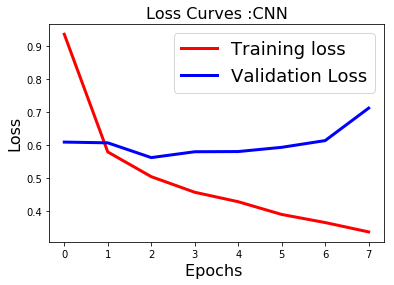
fig1 = plt.figure()
plt.plot(history.history['acc'],'r',linewidth=3.0)
plt.plot(history.history['val_acc'],'b',linewidth=3.0)
plt.legend(['Training acc', 'Validation acc'],fontsize=18)
plt.xlabel('Epochs ',fontsize=16)
plt.ylabel('Accuracy',fontsize=16)
plt.title('Accuracy Curves :CNN',fontsize=16)
plt.show()
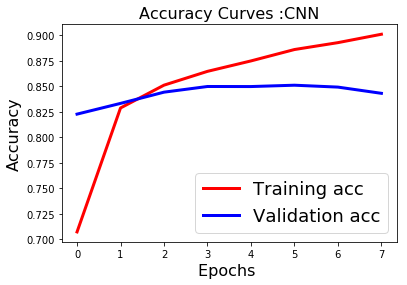
#predictions on test data
predicted=model.predict(test_data)
predicted
array([[8.0981451e-08, 1.0855978e-04, 2.4081068e-04, ..., 1.2183374e-08,
4.2278413e-14, 1.3356260e-03],
[4.4842030e-15, 4.8303903e-17, 3.0950001e-14, ..., 1.1857974e-27,
4.1175130e-29, 2.4889569e-18],
[8.0113517e-07, 8.7012697e-05, 2.1043130e-04, ..., 1.1248574e-05,
6.5152328e-11, 3.9855800e-06],
...,
[1.1208030e-05, 1.1443447e-04, 8.2766742e-04, ..., 7.2765088e-06,
4.9168783e-08, 2.9500878e-05],
[1.1967868e-06, 7.0446168e-07, 2.0910631e-09, ..., 1.2298947e-12,
4.2028167e-27, 5.5382466e-06],
[1.0300022e-10, 7.4779948e-12, 9.7130914e-10, ..., 5.6786068e-19,
2.3970355e-20, 9.0075374e-14]], dtype=float32)
#model evaluation
import sklearn
from sklearn.metrics import precision_recall_fscore_support as score
precision, recall, fscore, support = score(labels_test, predicted.round())
print('precision: {}'.format(precision))
print('recall: {}'.format(recall))
print('fscore: {}'.format(fscore))
print('support: {}'.format(support))
print("############################")
print(sklearn.metrics.classification_report(labels_test, predicted.round()))
precision: [0.86960203 0.83412322 0.85229759 0.90954594 0.77928102 0.74038462
0.93012871 0. 0.58653846 0.76732673 0.89770355]
recall: [0.71918768 0.57391304 0.78607467 0.81226054 0.91886964 0.46385542
0.94932976 0. 0.33516484 0.72093023 0.80827068]
fscore: [0.78727482 0.67997424 0.81784777 0.85815483 0.84333821 0.57037037
0.93963115 0. 0.42657343 0.74340528 0.85064293]
support: [1428 920 1982 3132 4388 166 3730 27 182 215 532]
############################
precision recall f1-score support
0 0.87 0.72 0.79 1428
1 0.83 0.57 0.68 920
2 0.85 0.79 0.82 1982
3 0.91 0.81 0.86 3132
4 0.78 0.92 0.84 4388
5 0.74 0.46 0.57 166
6 0.93 0.95 0.94 3730
7 0.00 0.00 0.00 27
8 0.59 0.34 0.43 182
9 0.77 0.72 0.74 215
10 0.90 0.81 0.85 532
micro avg 0.86 0.84 0.85 16702
macro avg 0.74 0.64 0.68 16702
weighted avg 0.86 0.84 0.84 16702
samples avg 0.84 0.84 0.84 16702
RNN
#Bidirectional LSTM
model = Sequential()
model.add(Embedding(len(word_index) + 1,
EMBEDDING_DIM,
weights=[embedding_matrix],
input_length=MAX_SEQUENCE_LENGTH,
trainable=True))
model.add(Bidirectional(LSTM(100, dropout_U = 0.2, dropout_W = 0.2)))
model.add(Dense(11,activation='softmax'))
model.compile(loss='categorical_crossentropy',
optimizer='rmsprop',
metrics=['acc'])
history = model.fit(train_data, labels_train,
batch_size=64,
epochs=8,
validation_data=(test_data, labels_test))
Train on 50104 samples, validate on 16702 samples
Epoch 1/8
50104/50104 [==============================] - 1310s 26ms/step - loss: 0.7421 - acc: 0.7711 - val_loss: 0.5399 - val_acc: 0.8337
Epoch 2/8
50104/50104 [==============================] - 1277s 25ms/step - loss: 0.4833 - acc: 0.8511 - val_loss: 0.4706 - val_acc: 0.8546
Epoch 3/8
50104/50104 [==============================] - 1257s 25ms/step - loss: 0.4076 - acc: 0.8736 - val_loss: 0.4423 - val_acc: 0.8619
Epoch 4/8
50104/50104 [==============================] - 1254s 25ms/step - loss: 0.3588 - acc: 0.8882 - val_loss: 0.4365 - val_acc: 0.8641
Epoch 5/8
50104/50104 [==============================] - 1253s 25ms/step - loss: 0.3195 - acc: 0.9003 - val_loss: 0.4372 - val_acc: 0.8627
Epoch 6/8
50104/50104 [==============================] - 1254s 25ms/step - loss: 0.2844 - acc: 0.9121 - val_loss: 0.4436 - val_acc: 0.8668
Epoch 7/8
50104/50104 [==============================] - 1255s 25ms/step - loss: 0.2528 - acc: 0.9211 - val_loss: 0.4605 - val_acc: 0.8638
Epoch 8/8
50104/50104 [==============================] - 1253s 25ms/step - loss: 0.2241 - acc: 0.9293 - val_loss: 0.4652 - val_acc: 0.8660
fig1 = plt.figure()
plt.plot(history.history['loss'],'r',linewidth=3.0)
plt.plot(history.history['val_loss'],'b',linewidth=3.0)
plt.legend(['Training loss', 'Validation Loss'],fontsize=18)
plt.xlabel('Epochs ',fontsize=16)
plt.ylabel('Loss',fontsize=16)
plt.title('Loss Curves :RNN - LSTM',fontsize=16)
plt.show()
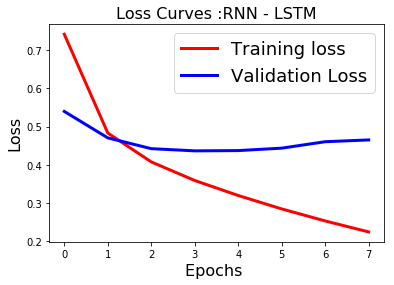
fig1 = plt.figure()
plt.plot(history.history['acc'],'r',linewidth=3.0)
plt.plot(history.history['val_acc'],'b',linewidth=3.0)
plt.legend(['Training acc', 'Validation acc'],fontsize=18)
plt.xlabel('Epochs ',fontsize=16)
plt.ylabel('Accuracy',fontsize=16)
plt.title('Accuracy Curves :RNN - LSTM',fontsize=16)
plt.show()
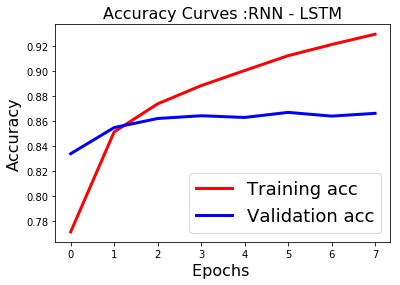
#predictions on test data
predicted=model.predict(test_data)
predicted
array([[2.9473981e-02, 5.8993626e-02, 4.3549597e-02, ..., 5.3076059e-05,
1.3519236e-04, 1.2607176e-03],
[3.1708100e-06, 1.8824825e-06, 8.0941909e-06, ..., 7.0293162e-08,
2.5478477e-07, 2.2799176e-07],
[5.1917366e-05, 3.2579785e-03, 3.9557324e-04, ..., 8.9214521e-04,
1.2622815e-05, 1.0268978e-04],
...,
[6.2825915e-04, 2.6230406e-04, 2.4657818e-03, ..., 3.9619839e-04,
1.0792948e-04, 2.8784707e-04],
[8.9328067e-04, 7.0826914e-05, 1.2235477e-05, ..., 1.4756889e-05,
5.9403064e-06, 1.5696751e-05],
[2.0625525e-06, 1.6432181e-05, 7.9930272e-05, ..., 5.1964469e-07,
4.3840672e-07, 5.2408077e-06]], dtype=float32)
#model evaluation
import sklearn
from sklearn.metrics import precision_recall_fscore_support as score
precision, recall, fscore, support = score(labels_test, predicted.round())
print('precision: \n{}'.format(precision))
print('recall: \n{}'.format(recall))
print('fscore: \n{}'.format(fscore))
print('support: \n{}'.format(support))
print("############################")
precision:
[0.88605578 0.76874206 0.86121571 0.9061445 0.86812444 0.71794872
0.93198339 0. 0.55333333 0.76068376 0.91164659]
recall:
[0.77871148 0.6576087 0.80776993 0.85696041 0.87762078 0.6746988
0.96246649 0. 0.45604396 0.82790698 0.85338346]
fscore:
[0.82892285 0.70884593 0.83363707 0.88086643 0.87284678 0.69565217
0.94697969 0. 0.5 0.79287305 0.8815534 ]
support:
[1428 920 1982 3132 4388 166 3730 27 182 215 532]
############################
print(classification_report(labels_test, predicted.round(),target_names=df1['product'].unique()))
precision recall f1-score support
Debt collection 0.89 0.78 0.83 1428
Consumer Loan 0.77 0.66 0.71 920
Mortgage 0.86 0.81 0.83 1982
Credit card 0.91 0.86 0.88 3132
Credit reporting 0.87 0.88 0.87 4388
Student loan 0.72 0.67 0.70 166
Bank account or service 0.93 0.96 0.95 3730
Payday loan 0.00 0.00 0.00 27
Money transfers 0.55 0.46 0.50 182
Other financial service 0.76 0.83 0.79 215
Prepaid card 0.91 0.85 0.88 532
micro avg 0.88 0.85 0.87 16702
macro avg 0.74 0.70 0.72 16702
weighted avg 0.88 0.85 0.87 16702
samples avg 0.85 0.85 0.85 16702
After hours of training we get good results with LSTM(type of recurrent neural network) compared to CNN. From the learning curves it is clear the model needs to be tuned for overfitting by selecting hyperparameters such as no of epochs via early stopping and dropout for regularization.
We could further improve our final result by ensembling our xgboost and Neural network models by using Logistic Regression as our base model.